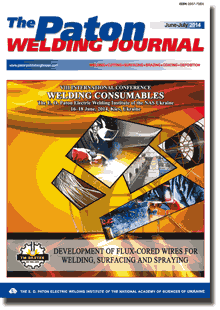| 2014 №06 (06) |
DOI of Article 10.15407/tpwj2014.06.07 |
2014 №06 (08) |

The Paton Welding Journal, 2014, #6-7, 35-39 pages
EFFECT OF SCANDIUM-CONTAINING WIRE ON STRUCTURE AND PROPERTIES OF JOINTS OF ALUMINUM-LITHIUM ALLOYS PRODUCED BY ARGON-ARC WELDING
L.I. MARKASHOVA, O.S. KUSHNARYOVA and I.I. ALEKSEENKO
E.O. Paton Electric Welding Institute, NASU. 11 Bozhenko Str., 03680, Kiev, Ukraine. E-mail: office@paton.kiev.ua
Abstract
Relevance of application of complex experimental-analytical approach for estimation of the most important mechanical properties is shown by the example of welded joints of complexly alloyed aluminum-lithium alloy 1460 of Al-Cu-Li system, produced by argon-arc welding using filler wires Sv-1201 and Sv-1201 + 0.5 % Sc. The estimation of service properties (strength, ductility, crack resistance) of the welded joints was carried out considering specific contribution of structural factors (chemical composition, grain, subgrain and dislocation structure as well as size and volume fraction of forming phase precipitates). Effect of each of specific structural-phase parameters on mechanical properties of the welded joints, their change under influence of postweld heat treatment and external loads as well as role of structural-phase condition for concentration and mechanism of relaxation of the internal stresses at metal alloying with scandium were determined. 12 Ref., 5 Figures.
Keywords: aluminum alloys, welded metal, scandium, heat treatment, structural-phase condition, phase precipitates, substructure, dislocation density, service properties, crack resistance
Received: 28.03.14
Published: 28.09.14
References
1. Markashova, L.I., Grigorenko, G.M., Arsenyuk, V.V. et al. (2002) Criterion for evaluation of mechanical properties of dissimilar material joints. In: Proc. of Int. Conf. on Mathematical Modelling and Information Technologies in Welding and Related Processes (16-20 Sept. 2002, Katsiveli, Crimea, Ukraine). Kiev: PWI, 107-113.
2. Fridlyander, I.N., Chuistov, K.V., Berezina, A.L. et al. (1992) Aluminium-lithium alloys. Structure and properties. Kiev: Naukova Dumka.
3. Davydov, V.G., Elagin, V.I., Zakharov, V.V. (2001) Studies of VILS in field of increase in quality and manufacturability of aluminium alloy semi-products. Tekhnologiya Lyog. Splavov, 5/6, 6-16.
4. Zakharov, V.V. (2003) Some problems in application of aluminium-lithium alloys. Metallovedenie i Termich. Obrab. Metallov, 2, 8-14.
5. Markashova, L.I., Grigorenko, G.M., Ishchenko, A.Ya. et al. (2006) Effect of scandium additions on fine structure of weld metal in aluminium alloy 1460 welded joints. The Paton Welding J., 2, 20-25.
6. Markashova, L.I., Grigorenko, G.M., Lozovskaya, A.V. et al. (2006) Effect of scandium additions on structure-phase state of weld metal in aluminium alloy joints after heat treatment. Ibid., 6, 7-11.
7. Markashova, L.I., Kushnaryova, O.S. (2012) Welded joints of complexly alloyed aluminium-lithium alloys, structure and operational properties. In: Transact. on Building, Materials Science, Machine-Building. Issue 64. Dnepropetrovsk: PGASA, 75-80.
8. Konrad, G. (1973) Model of deformation strengthening for explication of grain size effect on metal flow stress. In: Extrafine grain in metals. Ed. by L.K. Gordienko. Moscow: Metallurgiya, 206-219.
9. Kelly, A., Nickolson, R. (1966) Dispersion hardening. Moscow: Metallurgiya.
10. Goldshtejn, M.I., Litvinov, V.S., Bronfin, B.M. (1986) Physics of metals of high-strength alloys. Moscow: Metallurgiya.
11. Romaniv, O.N. (1979) Fracture toughness of structural steels. Moscow: Metallurgiya.
12. Koneva, N.A., Lychagin, D.V., Teplyakova, L.A. et al. (1986) Theoretical and experimental examination of disclinations. Leningrad: LFTI, 116-126.
